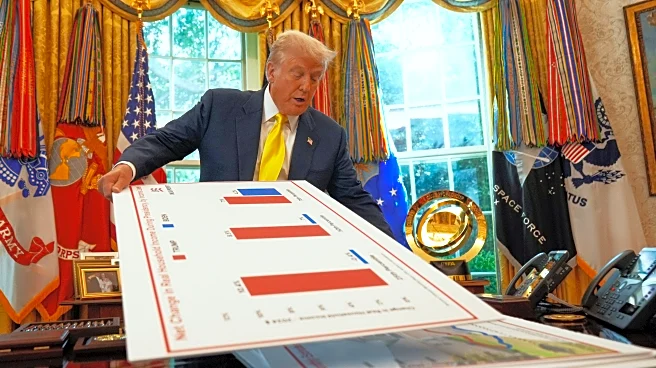Rapid Read • 8 min read
The U.S. Commerce Department has revised its estimate of the nation's GDP growth for the second quarter of 2025, indicating a 3.3% annual increase. This adjustment follows an initial estimate of 3% growth and reflects a rebound from a 0.5% contraction in the first quarter. The downturn earlier in the year was largely attributed to a surge in imports as businesses anticipated tariffs imposed by President Trump. The second quarter saw a significant reduction in imports, which fell at a 29.8% pace, contributing to the GDP growth. Consumer spending and private investment showed modest improvements, with consumer spending growing at a 1.6% annual pace, slightly better than previous estimates.
AD
The revised GDP figures highlight the impact of President Trump's trade policies on the U.S. economy. While the reduction in imports has boosted GDP growth, the tariffs have introduced uncertainty in the business environment, affecting investment decisions. The tariffs, aimed at protecting American industries, have been criticized by economists for potentially increasing costs and reducing efficiency. The resilience of the job market, however, has supported consumer spending, which remains a critical component of economic growth. The ongoing trade policy shifts could have long-term implications for U.S. economic stability and global trade relations.
As the effects of tariffs become more apparent, businesses and consumers may face increased costs, potentially slowing economic growth. The unpredictability of trade policy changes could continue to impact investment and hiring decisions. Economists predict that the economy may settle into a slower growth mode, with spending and growth around 1.5%. Monitoring the job market and consumer confidence will be crucial in assessing future economic trends.
The broader implications of President Trump's trade policies extend beyond immediate economic metrics. The shift away from decades of free trade policies could alter the U.S.'s position in global trade networks and affect international relations. The tariffs may also lead to inflationary pressures, impacting consumer prices and purchasing power. The long-term effects on American industries and their competitiveness in the global market remain uncertain.
AD
More Stories You Might Enjoy












